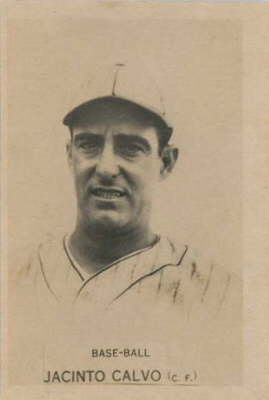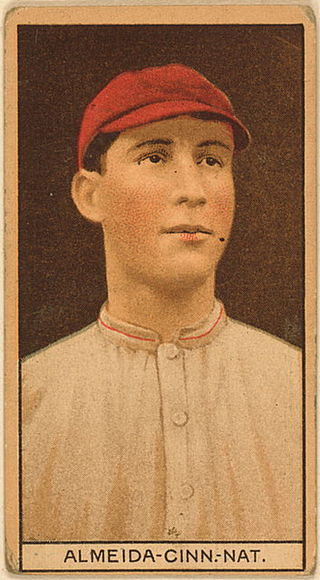Related Research Articles

Adolfo Domingo De Guzmán "Dolf" Luque was a Cuban starting pitcher in Major League Baseball (MLB) from 1914 to 1935. Luque was enshrined in the Cuban Baseball Hall of Fame in 1957 and the Cincinnati Reds Hall of Fame in 1967, as well as in the Mexican Baseball Hall of Fame in 1985. Luque was not only the first Latino pitcher in MLB, but also the first to win a World Series victory, and the first to lead the Leagues in wins and shutouts.
The Cuban League was one of the earliest and longest lasting professional baseball leagues outside the United States, operating in Cuba from 1878 to 1961. The schedule usually operated during the winter months, so the league was sometimes known as the "Cuban Winter League." It was always a small league, generally 3 to 5 teams, and was centered in Havana, though it sometimes included teams from outlying cities such as Matanzas or Santa Clara. The league became racially integrated in 1900, and during the first half of the 20th century the Cuban League was a premier venue for black and white players to meet. Many great black Northern American players competed in Cuba alongside native black and white Cuban stars such as José Méndez, Cristóbal Torriente, Adolfo Luque, and Martín Dihigo. After 1947, the Cuban League entered into an agreement with Major League Baseball and was used for player development. Following the 1959 Cuban Revolution, however, tensions rose with the new Communist government, and in March 1961 the government decreed the abolition of professional baseball.

Jacinto "Jack" Calvo González was born Jacinto Del Calvo in Havana, Cuba. He was an outfielder for the Washington Senators in 1913 and 1920. He played in 34 games, had 56 at bats, 10 runs, 9 hits, 1 triple, 1 home run, 4 RBIs, 3 walks, a .161 batting average, a .203 on-base percentage, a .250 slugging percentage, 67 total bases and 19 sacrifices. He died in Miami, Florida.

José Acosta was a Cuban-born starting pitcher in Major League Baseball who played three seasons for the Chicago White Sox and Washington Senators. Before joining the white minor leagues he played the 1915 season in "Negro baseball" as a member of the integrated Long Branch Cubans.

Armando Marsans Mendiondo was a Cuban professional baseball player who played as an outfielder in Major League Baseball from 1911 to 1918. He played in three different major leagues in his career: with the Cincinnati Reds in the National League (1911–1914), with the St. Louis Terriers in the Federal League (1914–1915), and with the St. Louis Browns and New York Yankees (1916–1918).

Rafael D. Almeida was a Major League Baseball third baseman from 1911 to 1913 with the Cincinnati Reds.
The Cuban Baseball Hall of Fame is a hall of fame that honors eminent baseball players from Cuban baseball. Established in 1939 to honor players, managers, and umpires in the pre-revolution Cuban League, by 1961 it had honored 68 players, managers, and umpires whose names are shown on a marble plaque at Havana's Estadio Latinoamericano. After the revolution, however, the Hall of Fame languished for more than 50 years, seldom mentioned or acknowledged and with no new inductees. Following a campaign led by Cuban filmmaker Ian Padrón, a meeting was held on November 7–8, 2014 to reformulate the Hall of Fame and to propose a museum in which it would be housed. The reformulated Hall recognized the original 68 members, and a jury of 25 people selected 10 new inductees—five from the pre-revolution period and five representing for the first time the post-revolution Cuban National Series. The planned site for the new museum is in the José Antonio Echeverría Workers' Social Club.

José Rodríguez, nicknamed "Joseíto" or "El Hombre Goma" in Spanish and "Joe" in English, was a Cuban infielder who played in Major League Baseball from 1916 to 1918 and in the Cuban League from 1914 to 1939. In the majors, he played for the New York Giants and was primarily a second baseman, while in the Cuban League and the U.S. minor leagues he mostly played first base. A defensive specialist, according to Roberto González Echevarría, Rodríguez "was considered the best defensive first baseman in Cuba" of his time. He was also a long-time manager in the Cuban League and managed for one season in the minors. He was inducted into the Cuban Baseball Hall of Fame in 1951.
The American Series was a set of baseball games played between Cuban and American teams in Cuba. An American team would travel to Cuba and play various professional, all-star and/or amateur Cuban teams throughout the country. The series usually took place either in the fall, after the end of the American season, or during spring training before the season began. The first American Series took place in 1879, with then minor league Worcester team going 2–0 against its Cuban opponents.

Pedro Dibut Villafana was a Major League Baseball pitcher who played for the Cincinnati Reds in 1924 and 1925. In 1923 Dibut played for the Cuban Stars (West) in the Negro National League, one of several white Cubans who played in both Negro league baseball and in the then-segregated major leagues.
The Leopardos de Santa Clara were a Cuban professional baseball team based in Santa Clara, Cuba. Founded in 1922, they played in the Cuban League from 1922 to 1925, from 1929 to 1930, and from 1935 to 1941. Although they competed for only 11 seasons, they won league championships in four regular seasons and in one "special season." According to Cuban League historian Jorge S. Figueredo, the 1923/24 team, which went 36–11 and won the championship by 11+1⁄2 games, is "considered as the most dominant team in the history of Cuban baseball."
Club Fé were a Cuban baseball team in the Cuban League based in Havana. They played in 1882, 1885, from 1887-1890, and again from 1901 to 1914.

Tomás Romañach was a Cuban baseball shortstop in the Cuban League and Negro leagues. He played from 1908 to 1916 with several clubs, including Almendares, Habana, the Long Branch Cubans, and the Cuban Stars (East). Romañach was nicknamed "El Italiano". He was elected to the Cuban Baseball Hall of Fame in 1948.
The Long Branch Cubans were a professional baseball team that played from 1913 to 1916. It was the first U.S. minor league baseball team composed almost entirely of Cubans. Several players, including Dolf Luque and Mike González, went on to play in the major leagues. The Cubans played in Long Branch, New Jersey from 1913 to 1915, except for the first half of the 1914 season, when they played in Newark, New Jersey. In 1916, they started the season playing in Jersey City, New Jersey as the "Jersey City Cubans." Later that summer, they moved their home games to Poughkeepsie, New York, where they were usually referred to as the "Long Branch Cubans." In late July 1916 they briefly moved to Harlem and finally to Madison, New Jersey in August.

José Borges was a Cuban baseball pitcher and second baseman in the Cuban League and Negro leagues. He played from 1902 to 1909 with several clubs, including Almendares, Nuevo Criollo and Club Fé, as well as competing in the Negro leagues for the Cuban Stars.
The Marianao baseball club played in the Cuban Professional League from the 1922–1923 season through to the 1960–1961 season. The club represented the populous town of Marianao in Havana and played their games at La Tropicana Stadium, official site of the league.
References
- Figueredo, Jorge S. (2003), Cuban Baseball: A Statistical History, 1878–1961, Jefferson, North Carolina: McFarland & Company, ISBN 078641250X